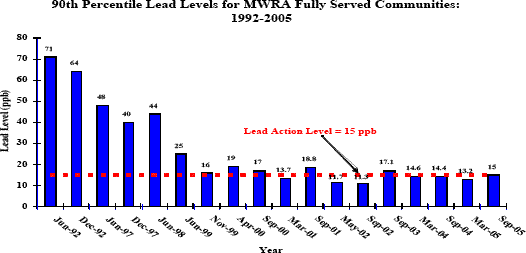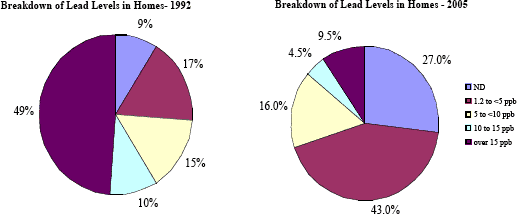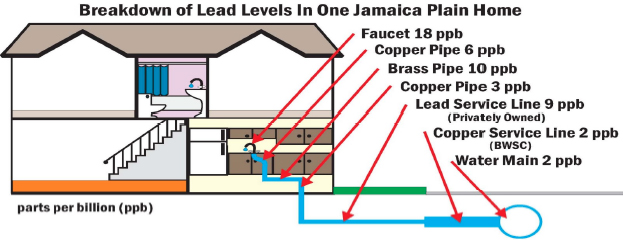(617) 788-1105, <ria.convery@mwra.state.ma.us>
Testimony of Massachusetts Water Resources Authority
Boston City Council – Committee on Health and Human Services
December 1, 2005
> Printer-friendly PDF document
Thank you for invitation to testify here today. My name is Stephen Estes-Smargiassi and I am Director of Planning at the MWRA. I have been involved in MWRA’s efforts to deal with the issues of lead in water since 1993. With me today are Tiffany Tran, the Design Manager for our corrosion control facilities, and Joshua Das, MWRA’s Project Manager for Public Health issues.
MWRA is the wholesale water provider to the Boston Water and Sewer Commission. We supply and treat the water, and sell it to BWSC through a series of master meters. BWSC distributes the water to individual properties.
The issues surrounding lead in drinking water have been a priority for MWRA since the federal Safe Drinking Water Act first began to require lead sampling in 1991. And MWRA and our community partners have worked diligently since then to reduce any risks from home plumbing containing lead.
EPA’s Lead and Copper Rule which is one part of the Safe Drinking Water Act requires that water systems sample for lead in certain homes, and depending on the results, provide corrosion control treatment to reduce the leaching of lead from home plumbing. In addition, water systems may be required to undertake education efforts to inform their customers about lead, and to remove any lead service lines which may still exist.
MWRA and its community partners, like BWSC, have done all this, and the test results are showing good progress.
Before providing the MWRA test results, I would like to provide some background and context on how we test and what the EPA requirements are.
With the promulgation of the lead and copper rule, EPA began requiring sampling for lead and copper in 1991. The samples are not the usual samples we are required to take of source water or of water as it leaves our treatment plant, but of stagnant water in individual homes. And not just any random homes or homes which are representative of average conditions within our service area, but homes which were judged by EPA to be of higher risk of having lead containing plumbing within the house, or in their front yards.
This is because we are not looking to see if there is lead in the source water or in the water in mains within city streets – we know that there is no lead in the source water and no lead in the water mains.
We are sampling to assess how corrosive the water is to home plumbing that contains lead, and to determine how effective our corrosion control treatment is. Water is naturally corrosive – it is often called the universal solvent – and certain pure soft waters like MWRA’s can be particularly so. Based on the first few rounds of sampling in 1992, MWRA initiated planning, design and construction of what we called the Interim Corrosion Control Facility in Marlborough in 1993. This plant was designed to be used until new permanent treatment facilities could be brought on line to satisfy a wider range of treatment requirements. It cost about $6.5 million to construct and around $2.5 million per year to operate.
We decided to build the interim corrosion control facilities after consulting with a group of public health professionals, pediatricians specializing in lead issues, the WIC (Women Infants and Children) program, citizen activist groups such as Conservation Law Foundation, EPA and DEP and others. They helped us decide to undertake the accelerated treatment plan, and helped us implement an aggressive outreach and education program. Their advice to MWRA was to design a program which was integrated with the work of the existing lead poisoning prevention programs at BPHC and MDPH, and coordinated with the WIC program which was already providing nutrition education to many of the most vulnerable population. Interestingly, the public health professionals were concerned that our efforts to educate about lead in drinking water would take away attention from the larger and more pressing risks of lead in paint and dust.
(As an aside, we frequently hear this from customers who call on our lead hot-line. Usually in response to a bottle water of home filter advertisement, they call concerned about their water. When our staff talk to them about lead and how to reduce their risk, they often haven’t realized the other exposures in their home.)
MWRA worked with WIC and EPA, designing brochures which had a simple message on avoiding lead risks from home plumbing. The WIC program also modified one of their early post partum visit protocols to include a section on lead and water. As they reached out to new mothers, they had a simple message, not overly complicated, but easy to follow, and presented at the critical time.
The message they recommended is to simply run the water before using it for drinking or cooking. There is no lead in the source water, nor in the water mains. Any lead in the water comes from the water sitting stagnant in home plumbing or lead services: simply letting the water run for a short time until it is fresh results in lead free water. We also provide information on what type of plumbing fixtures may contain lead, and how to get water tested.
We did the educational outreach suggested by the health group, and continue to do it today. We also built the corrosion control plant. After an accelerated design and construction period, it went on line in June of 1996. The choice of the treatment used, and the treatment levels were reviewed by a panel of national corrosion experts on several occasions, as recently as the spring of 2004. MWRA is serious about using its treatment facilities to get the maximum reduction possible. As can be seen from the graph of sampling results below, lead levels of stagnant water at the required high risk homes have declined around 80 percent since the plant went on line. We have recently completed the permanent water treatment plant, and are working with national experts to review our test data to determine if additional adjustments could result in further reductions.
90th Percentile Lead Levels for MWRA Fully Served Communities: 1992-2005 |
 |
| [NOTE - December 12, 2005: The 90% value listed for the MWRA service area (15 ppb) in the following testimony was based on preliminary results. The actual final 90% value is 13.8 ppb.] |
MWRA plays an important role in dealing with this issue. But we cannot solve it entirely on our own. We are responsible for treatment to reduce the natural corrosivity of our excellent source water. We can work with our member communities to reach out to at risk populations with information. Residents can do their part to use fresh not stagnant water for consumption – particularly if there are at risk individuals in their home – pregnant women, infants and young children. Local water departments are working to remove their portion of any remaining lead services and home owners can remove theirs. Boston has an excellent program to help homeowners do that. The state could also help with financial assistance to either cities or towns or directly to home owners. The federal government (or perhaps the state plumbing board) could remove the ridiculous loophole which continues to allow brass faucets and other fixtures to contain lead that can leach out (more on this below)
Sampling is a coordinated effort of MWRA, communities, and volunteers. BWSC locates homes which meet the rigid requirements of the Lead and Copper Rule. They then contact the resident and ask if they would participate in the sampling effort. If they agree, BWSC asks the state DEP to approve the location. If they do, MWRA prepares sample bottles and chain of custody forms. These are delivered by BWSC staff to the resident. The resident fills the bottle at a kitchen faucet (or a bathroom faucet) first thing in the morning before any water is used. This stagnant sample is returned to BWSC which delivers it to MWRA’s lab. We process the sample, and provide the results to DEP and BWSC. BWSC informs the resident of the test results in writing. MWRA staff may also contact the resident if the result is unusual to investigate further. These cases are usually locations with results which changed between sample rounds or which are higher than expected.
Results for the entire system and for each city or town are complied by MWRA. As required by the rule, we calculate the 90th percentile result. This is the level with 90 % of the results below it and only 10% above it. EPA requires that this result for the system not be above the “action level” of 15 parts per billion. If the 90th percentile results for the system is above the “action level”, MWRA and the communities must take certain actions (hence the name). MWRA must re-evaluate it corrosion control and try to optimize it. Residents must receive certain lead education materials, and communities may be required to remove lead services.
In this most recent sampling round, the MWRA 90th percentile was right at the action level, just passing. While MWRA did pass, we are still undertaking a review to further optimize treatment. But it is interesting to look not just at the single number. MWRA analyzed 444 samples. Over one quarter of these stagnant samples from higher risk homes had no detectable lead. More than 2/3 of these stagnant samples from higher risk homes had levels less than 5 parts per billion. Almost ¾ had levels of 5 ppb or less, and 86% of the samples were under 10 ppb. Only about 9.5 % were over 15 ppb.
Breakdown of lead levels in homes: 1992 vs. 2005 |
 |
In Washington DC in 2003, over 60 percent of their samples were over 15 ppb. MWRA has reduced levels from 49% over 15 ppb in 1992 to only around 9.5% over 15 now.
While our goal is to have no samples over 15, even in these higher risk homes, most samples are quite low.
More importantly, when we do test running water, almost every sample has either non-detectable results or only 2 or 3 parts per billion of lead.
MWRA and the communities collaborate with the volunteer samplers to take around 440 samples from higher risk homes twice each year. The regulations require that a system our size – serving over 2 million people – take only 100 samples. New York City, with around 5 times as many customers, takes only 100 samples. We have agreed with our state regulators at the Department of Environmental Protection to uniformly take more than 4 times as many samples across the service area to get a better idea of how our corrosion control treatment is working.
Individual results provide a snapshot of what is happening in an individual house when the water has sat stagnant. Because the sampling protocol is designed to evaluate the effectiveness of corrosion control, the results don’t provide real information about the water a typical customer would typically drink. We sample only the homes most likely to have any lead, and then sample that stagnant water most likely to have leached any lead. Most consumers don’t actually consume that stagnant water.
The lead in the samples we collect comes from brass faucets, brass plumbing pipes, or lead solder. The sampling protocol mandated by EPA doesn’t actually look at water in the service pipe. When we do sample this water, we often find that the results are lower than the water from the brass faucets. Every water is different, and it appears that MWRA water is slightly more corrosive to brass then to the old lead services (which have build up an internal protective coating).
MWRA doesn’t own lead services – cities and towns and individual home owners do. The service line is the connection from the pipe in the street to the house. It has two parts: the part from the water main to the property line (essentially the sidewalk) which is owned by the city or town (BWSC here in Boston) and the part from the sidewalk to the house which is owned by the property owner. Lead was used for these service lines from the time water supplies started up until the 1930’s.
To assist communities in dealing with lead services, MWRA amended its zero interest loan program for pipeline rehabilitation last year to specifically allow all aspects of lead service line replacement. This 10 year $250 million program is primarily focused on the rehabilitation or replacement of old unlined cast iron water mains, and each community receive an annual share based on the amount of unlined iron pipe it has. While lead services are always replaced when the pipe in the street is worked on – the program now allows communities to specifically target lead service lines even in areas where they are not working on the water mains.
Communities each have their own program to work with property owners to remove the privately owned portion of any lead service. BWSC has an excellent program with a grant and an on-call contractor to make it easier and cheaper for property owners to do their part.
MWRA and BWSC are working with the American Waterworks Association Research Foundation on a nationwide study of the relative contributions of various plumbing components and materials. The chart below shows results from one house in Jamaica Plain where a complete profile of lead contribution was made. A series of samples were taken, each representing the water in a particular portion of the plumbing all the way from a kitchen faucet to the pipe in the street. Free flowing samples always show either undetectable levels of lead or very low levels. The rest of the profile is more interesting. This home has a typical brass faucet, around 10 years old, copper piping below the sink, then some old threaded brass pipe, copper tubing with some lead containing solder (and some with lead-free solder). The service line is partly lead (from the house to the sidewalk) and then copper from there to the water main in the street.
The graphic below clearly shows elevated levels from the faucet itself and contributions from the old brass piping. The lead solder joints seem to contribute little lead. The contribution from the lead service is noticeable, but less than the faucet. The lesson I draw from this data is that the problem isn’t simple. If our goal is simply to reduce the levels in first draw samples, one solution may work. If we are interested in each and every contribution of lead, more work may be needed, by both the property owner and the water system. However, it is clear that the simplest short-term solution is to avoid stagnant water and to use fresh water from the main.
Breakdown of Lead Levels on One Jamaica Plain Home |
 |
As to the plumbing within a home, when Congress wrote the Safe Drinking Water Act in 1986, they defined brass with up to 8% lead as “lead free”. And even though Massachusetts has a stricter requirement, it is still too loose. New faucets can contain up to 3% lead, and often can allow too much lead to leach out. In our experience, the most common cause of a high test result is a new brass faucet. This obvious and outrageous loophole needs to be fixed by either the Federal government or the state government.
MWRA is working on many of these national topics. EPA asked MWRA and BWSC to be participants in a series of expert panels on finding problems with the existing rules and suggesting changes. MWRA and BWSC are participating in research sponsored by the American Waterworks Association Research Foundation on tracking down the lead contribution of various plumbing components. This will both advance our understanding of the problem and help us provide better advice to our customers. MWRA staff have also been invited by EPA to provide advice on improving national regulations on lead education efforts. And MWRA staff testified before Congress on behalf of the American Waterworks Association on what still needs to be done.
When the US Government Accountability Office reviewed lead reduction efforts nationwide earlier this year, they specifically called out the MWRA and community partnership on lead education as a national example of how to do it right. We were pleased to be singled out, but believe that this effort must be continued until every individual understands the potential risks of lead containing home plumbing and what steps they can take to reduce those risks.
Public health officials tell us that lead from water is almost never the sole cause of lead poisoning; nonetheless, we take our goals to educate our customers about lead and to reduce lead exposure seriously. Compounding this communication difficulty is the fact that the 15 ppb “action level” is not a health based standard, but a measure of treatment effectiveness. While it is clear that less lead is better, it cannot be said that a sample of water with 20 ppb lead is unsafe and another with 10 ppb is safe. We are working with consumers to encourage them to always use fresh water as we know that will always have less lead than water that has sat stagnant.
Thank you for this opportunity to provide the committee with information on our efforts on reducing the risks from lead.
# # #
PDF Files on this page require Adobe Acrobat® Reader. > Click here to download a free copy.